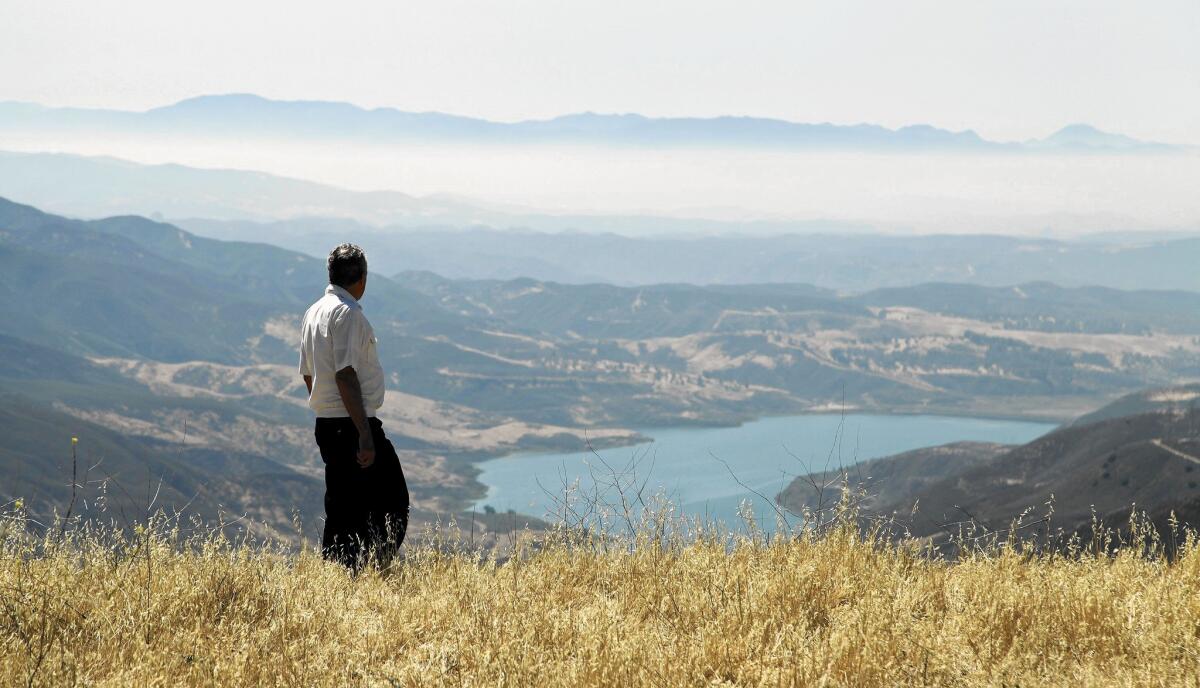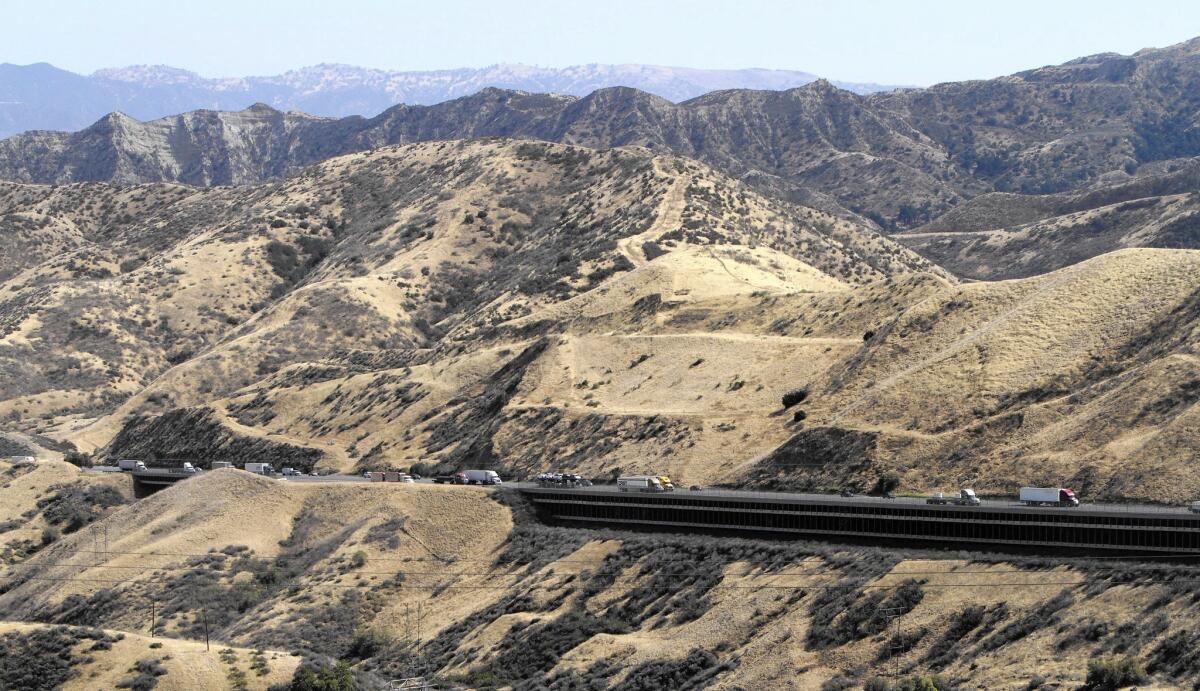Great Read: Why a historic highway that united California’s two halves may never reopen to cars

Harrison Scott, 79, has been trying for 25 years to save the Ridge Route, an engineering marvel that opened in 1915. But the retiree and amateur historian has found his proposal snarled in red tape.
Harrison Scott discovered the Ridge Route in 1955. Then 18, he was out freewheeling in a brand new Ford he’d bought with a loan from his parents.
The sinuous route, an engineering marvel that tamed the San Gabriel Mountains through the highway corridor that is now known as the Grapevine, was already a relic.
Opened in 1915, and credited by historians with uniting the economies of Northern and Southern California, the notoriously slow and dangerous roadway had been superseded in 1933 by Highway 99, itself to be replaced in 1970 by the 5 Freeway.
Scott liked the abandoned motorway, but did not return to the route until exploring it again in 1991, this time on a road trip with his son. Spurred by the boy’s interest, and retired from a long career with Pacific Telephone, Scott became an amateur historian and began collecting photos and stories of the highway.
He learned it had once been dotted with gas stations, diners, nightclubs and hotels that hosted gangsters and Hollywood stars. Clark Gable, Jean Harlow and Bugsy Siegel visited places such as Kelly’s Halfway Inn — set dead center in the 12-hour automobile journey between Bakersfield and Los Angeles — and Sandberg’s Summit Hotel, which had a sign by the front door that said, “No Dogs or Truck Drivers Allowed.”
The inns were long gone, but the roadway was intact. Scott began what has been a quixotic campaign to secure historic preservation status for the highway, and perhaps bring tourists back.
Sixty years after first driving the Ridge Route, Scott surveys it from a high bluff midway between Castaic and Gorman. He ran a hand over his sandy hair and said: “I didn’t think when I started this that I was going to die on this mountain. But now I do.”
::
The Ridge Route was born after engineering crews operating horse-drawn scrapers carved a narrow two-lane passage between Castaic and Grapevine, shaving 24 miles off the previous route. The new road included 697 curves and climbed to more than 4,000 feet above sea level.
Fully paved by 1919, it was considered a construction triumph. Though it featured dangerous curves and a speed limit of only 15 mph, the route was soon home to commercial enterprises.
Queen Nell’s Castle sold gasoline and cold soda. The National Forest Inn and Garage fed motorists home-cooked meals and fixed their broken flivvers.
The shorter drive attracted truck traffic and tourists. Its success helped quiet voices that had been calling for California to be cut in half.
“The Ridge Route made it possible for commerce and traffic and tourism to get between the two parts of California,” said Alan Pollock, president of the Santa Clarita Valley Historical Society. “This road united the two halves of the state.”
But in some ways, the route was too successful. The increased traffic demonstrated the need for a better, safer thoroughfare. Using newer construction techniques that allowed for a straighter route, Highway 99 opened in 1933 and cut an additional 10 miles off the trip.
The quaint Ridge Route began losing its businesses. The cafes and gas stations were gradually shuttered, many of them in the 1940s and ‘50s. Sandberg’s was destroyed in a 1961 fire. The once-grand but fading Hotel Lebec was torn down three years later. The Gorman Hotel was demolished in 1972.

Working with government officials, Scott succeeded in 1997 in getting the highway listed on the National Register of Historic Places. He wrote a book about the road, formed the nonprofit Ridge Route Preservation Organization to raise funds to maintain it, and organized volunteer work crews to ensure it was safe for driving, biking and hiking.
He hoped to have the route named a National Scenic Byway, like the Blue Ridge Parkway in the Appalachians, or the Natchez Trace Parkway, which runs through Mississippi, Alabama and Tennessee. That would have qualified the Ridge Route for federal money, Scott said, for signage, guardrails, vista pullouts and other improvements.
He had the written support of Rep. Kevin McCarthy (R-Bakersfield) and now-former Rep. Howard “Buck” McKeon (R-Santa Clarita), and there were precedents: Highway 1, through Big Sur, was given the same title in 1996, as later was the Arroyo Seco Scenic Parkway, a stretch of the 110 Freeway, in 2002.
But Scott gradually found his proposal snarled in red tape. In 2005, the Los Angeles County Board of Supervisors elected to vacate the Ridge Route, giving up their control of the mountain motorway and ceding stewardship to the U.S. Forest Service, over whose land the road had always traveled.
That should have helped Scott’s cause, until massive rainstorms in 2005 forced the Ridge Route’s closure. The Forest Service, without sufficient funds to repair storm damage to the road, erected huge metal gateways, and shut off access to all but the utilities and energy companies whose gas pipes or power lines still follow the Ridge Route.
Worse, the transfer of control of the roadway also relinquished easements onto it. Suddenly, access to the northern and southern ends of the Ridge Route, already gated, was in the hands of homeowners.
Scott began to believe he had been wasting his time.

A scenic view of Interstate 5 from Old Ridge Route. Harrison Scott, executive director of the Ridge Route Preservation Organization, has tried for 25 years to preserve the old highway that connected Los Angeles County and the San Joaquin Valley.
::
Today, despite Scott’s persistence, the stalemate continues. The Forest Service confirmed that it had given up the easements in question, and that the public Ridge Route is now landlocked by private citizens.
“The easements were not transferred,” said Sherry Rollman, the Forest Service’s public and legislative affairs officer.
The southern gate to the roadway is a 12.5-acre parcel owned by retired graphic artist Greg Olson, who said he has lived on the property for 26 years. Olson said he had several conversations with Forest Service officials and Scott’s Ridge Route Preservation Organization about granting right of passage, and was prepared to give it to them free of charge.
But those conversations ended in 2008 and never resumed. Olson, who has plans to develop the property, is no longer willing to reopen the road to full-time traffic.
Scott charges that the Forest Service has abrogated its responsibility to maintain the road for public use.
“This is our land!” he said, waving his arms at a remote stretch of the motorway. “The road was open for damn near 100 years. It’s a prescriptive right of way. The Forest Service can’t just close it.”
But it didn’t, Rollman said. “It’s not closed to the public,” she said. “It’s open for hiking, and biking, if you walk in. You just can’t drive there right now.”
SIGN UP for the free California Inc. business newsletter >>
Some who contend he’s wrong to expect the Forest Service to restore the road admire Scott’s single-minded commitment to it.
“Harrison does have the passion, and his heart is in the right place,” said Dianne Erskine-Hellrigel, a local hiking enthusiast who specializes in proposing wilderness legislation. “But the road is in bad shape, and it’s on Forest property, and there’s no funding.”
Even landowner Olson sympathizes with Scott’s frustration.
“I really like Scotty, and I like what he’s trying to do,” said Olson, who added he might support a limited opening of the road for a month or two a year. “I’m kind of in his way, even though I don’t want to be.”
Today, Scott, as founder of the Ridge Route nonprofit, is one of only a few private citizens with keys to the gates that block the historic roadway. Standing on a windy hill, he extolled the joys of early motor travel and the legacy of the old hotels and cafes — their ruins marked with plaques that Scott was instrumental in helping fund and install.
Many have been vandalized, stolen or destroyed. Upon one bluff are a crumbling stone archway and wall — partly rebuilt by Scott and his volunteers — that are the remains of the Tumble Inn, which boasted rooms, a restaurant and a Richfield filling station.
Scott said recently that the Forest Service may agree to let him and his work crew do light maintenance work again, for the first time in years.
Now 79, and having spent 25 years trying to save the road, Scott wonders whether the Ridge Route would still be open if he hadn’t begun the lobbying that led to its transfer to the Forest Service.
“It would have been better, I hate to say this, if I would’ve done nothing,” he said.
Twitter: @misterfleming
ALSO
Junk bond king Michael Milken looms large in L.A. finance industry
Hulu is developing a cable-like package of channels
Record number of firearms uncovered at nation’s airports







